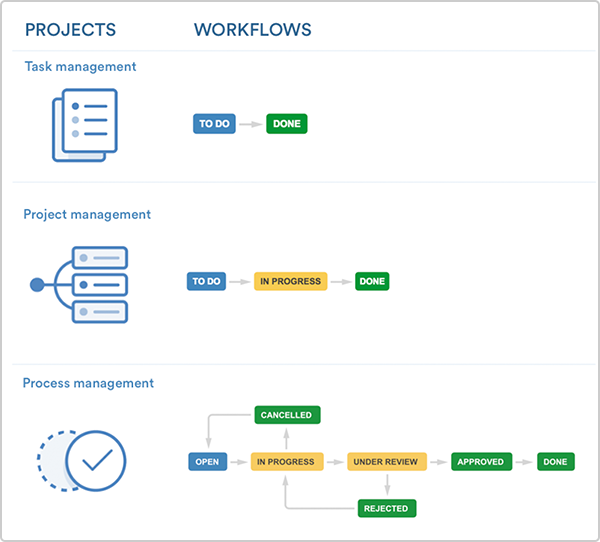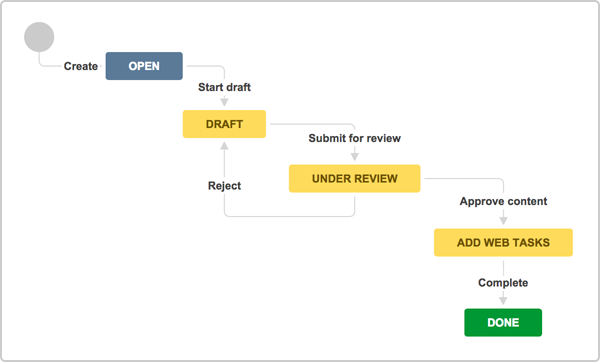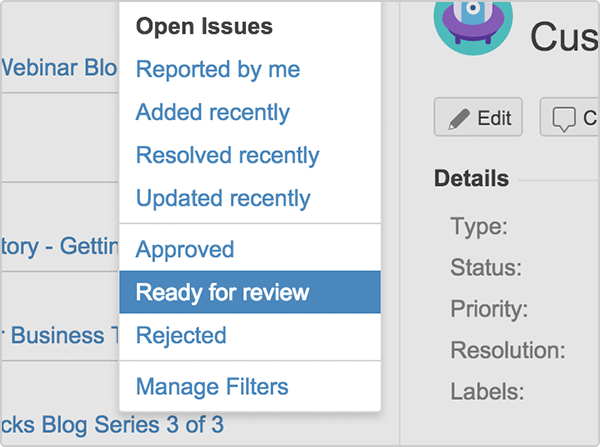When we surveyed users in 2014, we discovered that roughly a third of our customers used Jira for non-software projects. Customers were using Jira for marketing content review cycles and supply chain manufacturing processes and tracking patients for pharmaceutical trials. All using Jira, and all non-technical teams!
But despite the diversity of the businesses, there was a common denominator to their Jira use: business teams needed workflows to track work.
I bet some of you are thinking, “Hey, that’s just like my team!” Or, “I think our marketing team uses Jira? ” Or maybe even, “It sure would be cool if all the teams I work with used the same project management tool.”
That’s why we created Jira Core. Whether you’re new to Jira or a veteran power user, in this article you’ll find an overview of how to use and set up business workflows and discover some best practices for both admins and end-users that will help any team find workflow happiness.
Get the marketing workflow ebook
What are business projects and business workflows?
Business projects are the workflow templates that help business teams plan and track work. Workflows, in the context of business projects, help business teams define steps to get a task to done. You can find business projects in the create project section of Jira Software and Jira Service Desk, because Jira Core is included in every Jira instance. (Have more questions about Jira Core? Check out the announcement blog.)
These business projects, which include task management, project management, and process management workflows, are tailored for business teams. They can be used out-of-the-box or customized to match how your team works. Task management is for simple tasks, project management is for large projects like marketing campaigns, and process management is for reoccurring tasks like purchase approvals.

How to make a workflow for any project
Now that we’ve defined what a business project is, let’s do a quick review of workflow definitions:
- Issues are the things you need to do. But in business projects, issues are called tasks.
- A status represents the “state” of a task at a specific point in your workflow.
- A transition is a connection that links two statuses together, but only goes one way.
And let’s take this review one step further by putting these terms into practice. A common marketing process at Atlassian is writing a blog. The author and supporting team members go through several stages in a customized process management workflow. Below, we’ve outlined an example workflow and turned each step into statuses:
| To-Do | The blog that needs to be written |
| Draft | Blog work has started and is being written |
| Under Review | Content Manager reviews and edits the draft |
| Add Web Tasks | Blog manager adds tracking tags and SEO to the page |
| Live on Site | Blog manager uploads it on the site |
| Done | Task is done and closed |
After statuses are established, you need focus on transitions. Transitions prompt a user to move the task to the next step. For our blog review process, once the author has completed their draft, he or she can “Submit for review,” which moves the task to the content manager for review. Here’s a snapshot of our blog approval workflow:

As an added benefit, this process management workflow has pre-set filters so you can see which blogs need to be approved. (This is especially helpful for any of the approvers, i.e. our content managers.)

Remember to use advanced features to customize your workflow
In an ideal world, all of our blogs would follow the above workflow flawlessly. But in reality it’s rare that authors submit a blog that is perfect and ready to be published. To account for this at Atlassian, we’ve customized our content review workflow to include a lot of advanced features. This includes feature functionality like limiting who can do particular tasks, adding information before a status is transitioned, and adding an email notification after something has happened.
For example, at Atlassian, not everyone is authorized to approve content; only content managers can approve and publish blogs to atlassianblog.wpengine.com. Therefore, they are the only ones who can sign off and move the ticket from “Under Review” to “Add Web Tasks.” Adding this type of condition to a transition ensures that the right people are performing the right tasks.
Another real-world scenario at Atlassian? Needing to add an additional step before a person transitions a task from one status to another. When a blog’s first draft is rejected by the content manager, the blog author needs to know why. We have an additional comment field for when the task is transitioned from “Under Review” to “Draft,” so that the content manager can give edits and context for the rejection.
It might take some time to think about these advanced features in the context of business projects, but they follow the same formula as if you were setting up a software team workflow.
In fact, think about all the projects and workflows across your entire organization. Each business team can use these workflows and features to adapt to how their team works. Marketing teams not only write blogs, but they launch campaigns and create collateral. HR teams track candidates through the interview process, finance teams approve purchases and close financial books, and legal teams track document revisions to make sure everything is current.
Want more information about workflows?
Even though the above example is focused on a business team process, many of the ProTips, definitions, and features can be applied to any team. If you think your current workflow could be improved, or you want to create a business project, talk to your global admin. And if you’re the global admin, click the big green button for more ideas on how to customize workflows for business teams.
Customize your first business workflow
If you want more information on how workflows might work for other teams, check out this great series on building workflows and using workflows.
As excited about this post as we are? Share it on your social network of choice so your fellow marketers and non-technical colleagues can learn about business workflows, too!
